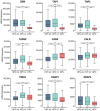Reduced MHC Class I and II Expression in HPV-Negative vs. HPV-Positive Cervical Cancers
- PMID: 36497170
- PMCID: PMC9741043
- DOI: 10.3390/cells11233911
Reduced MHC Class I and II Expression in HPV-Negative vs. HPV-Positive Cervical Cancers
Abstract
Cervical cancer (CC) is the second most common cancer in women worldwide and the fourth leading cause of cancer-associated death in women. Although human papillomavirus (HPV) infection is associated with nearly all CC, it has recently become clear that HPV-negative (HPV-) CC represents a distinct disease phenotype with increased mortality. HPV-positive (HPV+) and HPV- CC demonstrate different molecular pathology, prognosis, and response to treatment. Furthermore, CC caused by HPV α9 types (HPV16-like) often have better outcomes than those caused by HPV α7 types (HPV18-like). This study systematically and comprehensively compared the expression of genes involved in major histocompatibility complex (MHC) class I and II presentation within CC caused by HPV α9 types, HPV α7 types, and HPV- CC. We observed increased expression of MHC class I and II classical and non-classical genes in HPV+ CC and overall higher expression of genes involved in their antigen loading and presentation apparatus as well as transcriptional regulation. Increased expression of MHC I-related genes differs from previous studies using cell culture models. These findings identify crucial differences between antigen presentation within the tumor immune microenvironments of HPV+ and HPV- CC, as well as modest differences between HPV α9 and α7 CC. These differences may contribute to the altered patient outcomes and responses to immunotherapy observed between these distinct cancers.
Keywords: T cell; The Cancer Genome Atlas (TCGA); cervical cancer (CC); gene expression; human papillomavirus (HPV); major histocompatibility complex (MHC).
Conflict of interest statement
The authors declare no conflict of interest.
Figures







Similar articles
-
HPV-Positive and -Negative Cervical Cancers Are Immunologically Distinct.J Clin Med. 2022 Aug 18;11(16):4825. doi: 10.3390/jcm11164825. J Clin Med. 2022. PMID: 36013065 Free PMC article.
-
Analysis of Class I Major Histocompatibility Complex Gene Transcription in Human Tumors Caused by Human Papillomavirus Infection.Viruses. 2017 Sep 10;9(9):252. doi: 10.3390/v9090252. Viruses. 2017. PMID: 28891951 Free PMC article.
-
HPV 16 infection and progression of cervical intra-epithelial neoplasia: analysis of HLA polymorphism and HPV 16 E6 sequence variants.Int J Cancer. 1998 Oct 5;78(2):166-71. doi: 10.1002/(sici)1097-0215(19981005)78:2<166::aid-ijc8>3.0.co;2-x. Int J Cancer. 1998. PMID: 9754647
-
Are 20 human papillomavirus types causing cervical cancer?J Pathol. 2014 Dec;234(4):431-5. doi: 10.1002/path.4424. J Pathol. 2014. PMID: 25124771 Review.
-
Human papillomavirus type 18: association with poor prognosis in early stage cervical cancer.J Natl Cancer Inst. 1996 Oct 2;88(19):1361-8. doi: 10.1093/jnci/88.19.1361. J Natl Cancer Inst. 1996. PMID: 8827013 Review.
Cited by
-
Towards Novel Gene and Cell Therapy Approaches for Cervical Cancer.Cancers (Basel). 2022 Dec 30;15(1):263. doi: 10.3390/cancers15010263. Cancers (Basel). 2022. PMID: 36612258 Free PMC article.
-
Effects of Dietary Steroid Saponins on Growth Performance, Serum and Liver Glucose, Lipid Metabolism and Immune Molecules of Hybrid Groupers (♀Epinephelus fuscoguttatus × ♂Epinephelus lanceolatu) Fed High-Lipid Diets.Metabolites. 2023 Feb 19;13(2):305. doi: 10.3390/metabo13020305. Metabolites. 2023. PMID: 36837925 Free PMC article.
-
Anogenital HPV-Related Cancers in Women: Investigating Trends and Sociodemographic Risk Factors.Cancers (Basel). 2024 Jun 8;16(12):2177. doi: 10.3390/cancers16122177. Cancers (Basel). 2024. PMID: 38927883 Free PMC article.
-
Bioinformatics analysis of immune characteristics in tumors with alternative carcinogenesis pathways induced by human papillomaviruses.Virol J. 2023 Dec 4;20(1):287. doi: 10.1186/s12985-023-02241-6. Virol J. 2023. PMID: 38049810 Free PMC article.
-
Efficacy and Safety of Atezolizumab as a PD-L1 Inhibitor in the Treatment of Cervical Cancer: A Systematic Review.Biomedicines. 2024 Jun 11;12(6):1291. doi: 10.3390/biomedicines12061291. Biomedicines. 2024. PMID: 38927498 Free PMC article. Review.
References
-
- de Sanjose S., Quint W.G.V., Alemany L., Geraets D.T., Klaustermeier J.E., Lloveras B., Tous S., Felix A., Bravo L.E., Shin H.-R., et al. Human papillomavirus genotype attribution in invasive cervical cancer: A retrospective cross-sectional worldwide study. Lancet Oncol. 2010;11:1048–1056. doi: 10.1016/S1470-2045(10)70230-8. - DOI - PubMed

